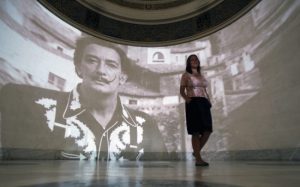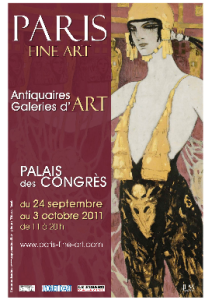1. Es busca: tallador per a un gran diamant en brut.
Que el Museu Nacional d’Art de Catalunya té potencial per a convertir-se en un museu de referència internacional en més d’un aspecte, és quasi un tòpic en el món de la museografia catalana. Però que encara s’ha de trobar el director o directora que ho faci possible, també. Ara hi ha una nova oportunitat. El 19 de septembre passat es va obrir la fase de presentació de candidatures per a ocupar el càrrec. El termini acaba el proper 30 d’octubre i les bases estableixen, com a requisit, que el candidat presenti “una visió clara de com de ser la situació del MNAC, en totes les seves àrees d’activitats, tant a nivell nacional com internacional”. Es tracta d’un contracte per cinc anys. Altres detalls de la convocatòria, incloent la composició del tribunal, es poden trobar a la web del MNAC.
2. Èxit de Dalí a Moscou.
La Fundació Gala-Salvador Galí rep uns 1.300.000 visitants (dades oficials del 2010) a les seves tres seus, capitanejades pel Teatre Museu de Figueres (un teatre en runes renovat i convertit en “objecte surrealista” segons els plans del mateix Dalí). D’aquests visitants, uns 130.000 són russos i aquesta és una de les raons que ha portat a la Fundació a organitzar una antològica al Puskhin Museum de Moscou (“Salvador Dalí: una retrospectiva”, del 3 de setembre al 13 de novembre) La generosa sel·lecció de préstecs, una presència notable de Gala (la musa russa de Dalí), l’escenografia espectacular deguda a Boris Messerer, pintor i escenògraf del Bolshoi i, naturalment, l’atractiu del nom Dalí han portat a un èxit de públic ressonant.
3. Rússia al Prado.
També dins de l’Any 2011 Dual Espanya – Rússia, l’Hermitage desembarcarà al Museo del Prado el proper 8 de novembre (“Tesoros del Hermitage”, fins el 25 de març de 2012). Segons el que s’ha anat avançant, l’Arca Russa arribarà carregada amb tresors de totes les classes i de tots els temps, des d’arqueologia del segle V a.C. fins a les avantguardes del segle XX d.C. Estem segurs que aquest enfoc enciclopèdic, amb un toc tradicional, serà irrestible. De fet, el Dr. Gabrielle Finaldi, comissari de la mostra i Director de Recerca al Prado, ja l’ha qualificada de “meravellosa”.
4. Els invasors tenien bon gust.

Gràcies a una innovadora tècnica d’escaneig, un equip conjunt del Rijksmuseum i les universitats d’Anvers i Delft, han descobert un retrat desconegut de Goya, amagat sota el “Retrat de Ramon Satué” a la col·lecció del museu. Encara que es tracta d’una obra inacabada, es pot apreciar clarament que el retratat vestia un uniforme francès i ostentava les condecoracions més altes del règim de Joseph de Bonaparte, només concedides als seus generals. Es publicarà un article sobre la descoberta a l’edició d’octubre del Burlington Magazine. En qualsevol cas, es tracta d’un cas interessant per estudiar l’adaptació dels artistes espanyols al nou règim.
5. L’etern atractiu de Paris.
Gràcies a un “Diaporama” firmat per Lucie Agache a la sempre interessant Conaissance des Arts Newsletter, ens ha arribat la notícia d’una altra fira d’art a Paris, anomenada simplement “Paris Fine Art” i oberta des del 24 de setembre al 3 d’octubre. Si ho haguéssim sabut amb més temps, segur que hi haguéssim anat, perquè en aquestes fires mitjanes es poden fer bones descobertes. Cas que us hi animéssiu i després volguéssiu fer-nos saber els vostres descobriments, aquest blog està del tot obert.
6. I per partida doble.
Un altre cop gràcies a la combinació de Connaisance des Arts Newsletter i Paris, donem notícia de l’exposició “Fra Angelico et les Maîtres de la Lumière” al Musée Jacquemart André de la capital francesa. En una entrevista modèlica a la mateixa web de Connaissance el comissari Nicolas Sainte-Fare-Garnot necessita només uns 7 minuts per ampliar el tema del Fra Angelico com el pas entre l’Edat Mitjana i el Renaixement a altres aspectes: el past del claustre a la ciutat, el pas de la prèdica basada en la paraula a la prèdica basada en la imatge, el pas de la pintura plana a la perspectiva amb profunditat, aconseguida gràcies al joc de la llum i l’ombra.
7. Un clàssic d’Internet.
Comencem aquesta nova secció sobre projectes que han durat més d’una dècada en el món online (és a dir, un segle en les nostres vides offline) i destaquem la venerable “Heilbrunn Time Line of Art History”, inaugurada al 2000 a la web del Metropolitan Museum website. Cobreix no menys de 10.000 anys d’història i totes les grans cultures d’aquest món, de manera que sempre és la referència quan es necessita el gran marc general.
Trobeu a faltar alguna cosa? Envieu-me les vostres bones idees com a comentari aquí sota o bé per email a jordi@jordidenadal.com.



